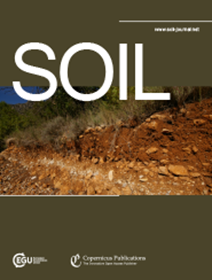如何以及何时检测土壤碳饱和度的六项权利
IF 5.8
2区 农林科学
Q1 SOIL SCIENCE
引用次数: 0
摘要
摘要。二十多年前,随着我们对土壤有机碳(SOC)稳定机理认识的加深,土壤有机碳(SOC)饱和度的概念应运而生。最近,随着这一概念在多种土壤类型和环境中的进一步验证,一些人对土壤有机碳饱和度的基本原理提出了质疑。在此,我们认为,要检验这一概念,应该注意六项基本原则或 "权利"(R):正确的措施、正确的单位、正确的分散能量和应用、正确的土壤类型、正确的粘土类型以及正确的饱和度。一旦我们在各项研究中都考虑到了这六项权利,我们就会发现矿物稳定的碳的最大值,并根据现有数据估计,对于 2 :而对于 1 :而对于 1 : 1-粘土为主的土壤,则很可能只有约 46 ± 4 g C kg-1 淤泥 + 粘土。利用更多数据,特别是不同环境条件下不同粘土类型的数据,可以进一步改进这些估计值。然而,更大的挑战在于要实施哪些固碳策略以及如何实施这些策略,以便在全球土壤中有效地达到 82/46 克 C kg-1 淤泥+粘土的固碳水平。本文章由计算机程序翻译,如有差异,请以英文原文为准。
The six rights of how and when to test for soil C saturation
Abstract. The concept of soil organic carbon (SOC) saturation emerged a bit more than 2 decades ago as our mechanistic understanding of SOC stabilization increased. Recently, the further testing of the concept across a wide range of soil types and environments has led some people to challenge the fundamentals of soil C saturation. Here, we argue that, to test this concept, one should pay attention to six fundamental principles or “rights” (R's): the right measures, the right units, the right dispersive energy and application, the right soil type, the right clay type, and the right saturation level. Once we take care of those six rights across studies, we find a maximum of C stabilized by minerals and estimate based on current data available that this maximum stabilization is around 82 ± 4 g C kg−1 silt + clay for 2 : 1-clay-dominated soils while most likely being only around 46 ± 4 g C kg−1 silt + clay for 1 : 1-clay-dominated soils. These estimates can be further improved using more data, especially for different clay types across varying environmental conditions. However, the bigger challenge is a matter of which C sequestration strategies to implement and how to implement them in order to effectively reach this 82/46 g C kg−1 silt + clay in soils across the globe.
求助全文
通过发布文献求助,成功后即可免费获取论文全文。
去求助
来源期刊

Soil
Agricultural and Biological Sciences-Soil Science
CiteScore
10.80
自引率
2.90%
发文量
44
审稿时长
30 weeks
期刊介绍:
SOIL is an international scientific journal dedicated to the publication and discussion of high-quality research in the field of soil system sciences.
SOIL is at the interface between the atmosphere, lithosphere, hydrosphere, and biosphere. SOIL publishes scientific research that contributes to understanding the soil system and its interaction with humans and the entire Earth system. The scope of the journal includes all topics that fall within the study of soil science as a discipline, with an emphasis on studies that integrate soil science with other sciences (hydrology, agronomy, socio-economics, health sciences, atmospheric sciences, etc.).
 求助内容:
求助内容: 应助结果提醒方式:
应助结果提醒方式:


